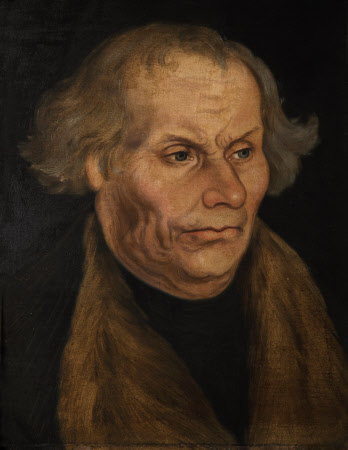Hans Luther (1459-1530) (after Lucas Cranach the elder)
Robert Scott Tait (1816 - 1897)
Category
Art / Oil paintings
Date
1854
Materials
Oil on panel
Measurements
356 x 305 mm (14 x 12 in)
Place of origin
England
Order this imageCollection
Carlyle's House, London
NT 263717
Summary
Oil painting on panel, 'Hans Luther (1459-1530) (after Lucas Cranach the elder)', by Robert Scott Tait (1816-97), 1854.
Full description
The historian Thomas Carlyle (1795 - 1881) travelled to Germany in September 1852, where he toured to places with connections to people he admired. This included the Wartburg, a castle in Eisenach, where Martin Luther (1483 - 1546) translated the New Testament from ancient Greek into German in 1521-2. Carlyle was greatly interested in Luther, including him in a series of lectures published under the title On Heroes, Hero-Worship, and the Heroic in History in 1841. In these, Carlyle presented his theory that 'Universal History, the history of what man has accomplished in this world, is at bottom the History of the Great Men who have worked here.' After visiting the Wartburg, Carlyle wrote to his mother, Margaret, on 19 September, describing the room in which Luther lived and worked in the early 1520s and two portraits of Luther's mother and father, painted by Lucas Cranach the Elder (c.1472 - 1553): 'excel[en]t old Portraits, the Father with a dash of thrift, contention and worldly wisdom in his old judicious peasant countenance... '. [See TC-MAC, 19 Sept 1852, published in The Carlyle Letters Online.] Rosemary Ashton has speculated that Carlyle identified Luther's parents with his own (p. 325, Portrait of a Marriage), both of whom were deeply religious. In his Reminiscences, Carlyle portrayed his 'peasant father' with great affection as a man 'educated by experience' [p. 15], who 'had known poverty in the shape of actual want (in boyhood) and never had one penny which he knew not well how he had come by' [p. 22, Reminiscences, vol. I, 1881]. In 1854, Robert Tait (1816-97) photographed both Jane and Thomas Carlyle and their home on Cheyne Row, and then set off for Germany. There, he too went to Eisenach, where he spent three days making copies of the Cranach paintings of Luther's parents. Tait gave these to Carlyle and received in response a letter in which Carlyle wrote, 'The Luther portraits are a decidedly welcome possession to me … They shall hang on my walls here; in daily sight of me...' [See TC-RST, 15 Jan 1855, published in The Carlyle Letters Online.] The companion painting of Martin Luther's mother is NT 263716.
Provenance
Presented to Thomas Carlyle (1795-1881) by Robert Tait in 1854; returned to Tait (1816-97) on Carlyle's death; by descent to the artist's daughter, Mildred Scott Tait (1860 - 1950), who gave the portrait to Alicia Joanna Royston (1864 - 1933); by whom bequeathed to the National Trust.
Credit line
Carlyle’s House, Chelsea (National Trust)
Marks and inscriptions
Along bottom edge.: ...at the Wartburg-Dor 2nd September 1854 in Luther's Room
Makers and roles
Robert Scott Tait (1816 - 1897), publisher after Lucas Cranach the Elder (Kronach 1472 - Weimar 1553), publisher
References
Carlyle, 1997: Thomas Carlyle, Reminiscences. Ed. K. J. Fielding and Ian Campbell. Oxford: Oxford University Press, 1997. Ashton 2002: Rosemary Ashton, Thomas and Jane Carlyle: Portrait of a Marriage (2002), Chatto & Windus Carlyle 2023: Carlyle Letters Online (Duke University Press), 2023. https://carlyleletters.dukeupress.edu

